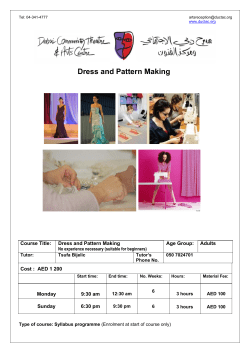
— Wedding Dress 2004 Sewing Pattern
Sewing Pattern — Wedding Dress 2004 Recommendations on fabric: lightweight lace; heavy satin; lightweight fatin/veiling (preferable of two of white, e. g. milk white and cream white); medium weight fatin/veiling; lace trim of 4-5 cm wide You will also need: zipper, metal or plastic boning, 2 decorative chiffon flowers If the pattern has a double line around it, the seam allowances are included. Note: By default, seam allowances are NOT included (single line) and will need to be added when laying out and cutting details. Seam allowance: along left side seam (for zipper) of the garment - 2 cm, other seams - 1 cm Attention! First of all, please print all the paper patterns and lay them out at the width of fabric you plan to use (usually from 90 to 150 cm) to see how much fabric you will need. Don't forget to take into account pieces to be duplicated or cut on a fold. When sewing the garment, pay attention to notches. They must match up with corresponding pieces. CUTTING: The word, “beam” used on some patterns means “straight of grain”. Some pieces will be cut on the fold, this is noted on the pattern piece. Mark all notches and other design features such as darts, pleats etc. from the pattern onto your fabric. Fabric: Satin (atlas): 1. Back skirt – cut 2 2. All pieces of the bodice 3. All bias tapes Fusible interfacing: 1. All pieces of the bodice 2. All bias tapes Lightweight fatin/veiling: 1. Goffered inset (an ornamental frill made by pressing pleats) of the skirt – cut 1 2. Front skirt – cut 1 3. Back skirt –cut 2 Pattern #2004, page 1 of 3 All sewing patterns at www.lekala.co Lightweight lace: 1. All pieces of the bodice 2. Front skirt - cut 1 3. Back skirt – cut 2 Medium weight fatin/veiling: 1. Underskirt – cut 1 on fold Lining: 1. Skirt Decoration: as a decoration use lace trim of 4-5 cm that is topstitched under satin bias tapes. INSTRUCTIONS: 1. All front bodice pieces consist of fused satin (for less transparency and for structure) and one layer of lace fabric. We also recommended using fused satin for the bodice lining. 2. All seams of the bodice should have metal or plastic boning which is 2 cm shorter than the seam (for easier sewing). 3. After sewing bodice seams, cover them additionally with bias tape and lace trim. 4. Skirt consists of 5 separate layers. Upper layer of the front skirt from goffered fatin/veiling is stitched to upper layer of the back skirt that is from lightweight lace. Topstitch lace decoration trim along seam lines with zig zag stitch. Also topstitch lace trim along the lower edge of the skirt – so the seam is finished. 5. Second layer of the skirt: sew center front skirt of lightweight lace to the back skirt of satin. 6. Third layer of the skirt: sew center front skirt of lightweight fatin/veiling to the back skirt of lightweight fatin/veiling. 7. Fourth layer of the skirt: underskirt from medium-weight fatin/veiling. 8. Fifth layer: lining of the skirt. 9. Zipper in side seam of the bodice. 10.Tack the lace bias tape to ready bodice along the edge with hand stitches. 11. Cover skirt and bodice connection line with bias tape, folded in half and pressed as shown on shaped bias tape pattern. Sew bias tape by hand (placing the dress on a mannequin will make it easier. 12. On left side of the skirt fasten 2 decorative chiffon flowers to goffered insets. Pattern #2004, page 2 of 3 All sewing patterns at www.lekala.co TECHNICAL DRAWING: Pattern #2004, page 3 of 3 All sewing patterns at www.lekala.co
© Copyright 2025





















